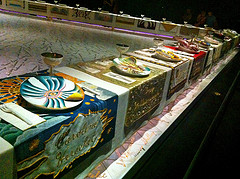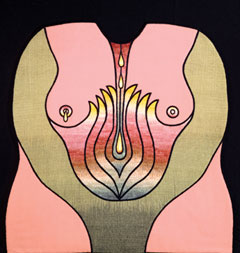Set to celebrate her 75th birthday next month, June’s artist in profile is…
Judy Chicago

Her famous work, a multimedia project entitled “The Dinner Party” is five years in the completion and is considered by many to be her finest work. It features a long table upon which are 39 different illustrated plates. Each of the plates features a woman of some distinction and overall the piece is the story of women’s history in western civilisation
The Beginning
As a child, Chicago took art classes at the Art Institute of Chicago and later studied art in Los Angeles at UCLA. She met her first husband, Jerry Gerowitz and they married in 1961. The relationship was rocky and stormy and Jerry died after two years of marriage in a car accident.
While Chicago was in graduate school, her style developed distinctive imagery of the female in her paintings. This imagery was deplored by one of her instructors, so she moved into sculpture. Los Angeles in the sixties had a macho pop art vibe and to try and prove herself in that genre, she attended vehicle body building and boat building schools as well as becoming apprentice to a pyro technician.

Starting her career, Chicago worked at several California universities as a painting instructor and in 1970 launched the very first feminist art programme in the state university at Fresno. Following her own ideology, she dropped her surname of Cohen and adopted the name Chicago. To her, this avoided being part of the traditional naming conventions of bearing the name of the father or husband.
Famous Works

Later Career
A labour of love, the piece begun in 1994 “Resolutions: A Stitch in Time” took six years to finish. Combining needlework and paintings, Chicago created re-imagined traditional proverbs to incorporate a multi-cultural futurescape. In 2000 the work went on display in New York at the Museum of Art and Design.

In her long and robust career, Judy Chicago has received many accolades. She holds several honourary doctorates from Duke University and Smith College and in 2012; she was honoured with a lifetime achievement award at the Palm Springs Art Fair.
Taking inspiration from the women’s movement while rebelling against the male-dominated art scene in the sixties, Chicago worked with explicit female content. Her creative process produced works that recognised achievements of female historical figures or rejoiced in the unique experience of women. Chicago’s body of work has added women to historic record and enhanced their visual art representation.
Judy Chicago always chooses to create thought provoking art often stirring up controversy with some of her images. Her artwork is well-established and forms part of the collections of numerous leading art institutions.
